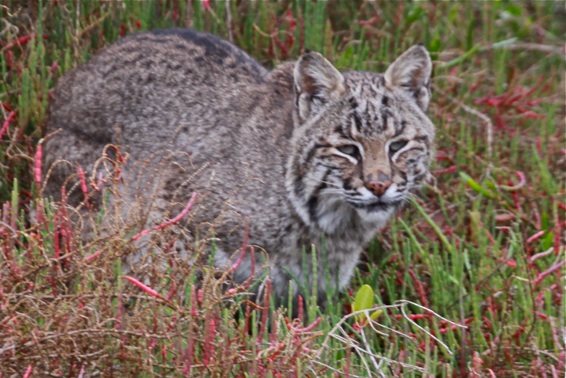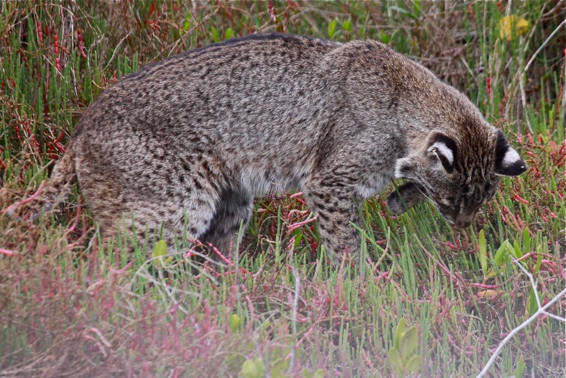The Nature
Observer’s Journal
The Nature
Observer’s Journal

The Cat in the Glasswort
Chuck Tague
The Halifax Audubon made the mandatory stop at the Cruikshank Trailhead on our unscheduled field trip around Black Point Wildlife Drive in Merritt Island National Wildlife Refuge. It’s the only outdoor rest stop in the refuge.
I was the first one on the observation platform that overlooks a salt meadow on one side and a borrow ditch lined with mangroves on the other. There I spotted a Green Heron perched on a mangrove and I called the group over. Perhaps I was a bit too loud, but the heron didn’t flush. Soon every one in our group, plus a few others, had binoculars on the heron. The bird was focused on the water below and waited with unwavering patience for a fish to swim by. I turned away from the motionless bird and looked directly into the eyes of a Bobcat across a narrow canal. For a second our gazes locked.

I whispered, “Freeze and slowly turn around.” I expected the cat to bolt and hoped some of the birders would get a quick glimpse of its bobbed tail before it disappeared into the brush. The group responded to my contradictory command as anyone would, they spun around. I heard gasps when they saw the cat. The cat didn’t run. Instead it turned away and stared into the green and red plants that covered the bank. There was an animal hiding there and the Bobcat would not be deterred.
The green and red plant was Perennial Glasswort, a low-growing, salt-tolerant succulent that grows in salt marshes, salt flats and along the edge of brackish wetlands. It has jointed, branched stems that form dense thickets that make great cover for snakes and rodents. The cat pivoted around a dense glasswort clump. Its eyes fixed on one spot; its concentration was intense. Soon the cat’s back was to the platform. I moved forward and braced my camera on the lowest rail. Behind me the cameras clicks sounded like a presidential press conference. The cat didn’t give a damn about the people or the cameras. It raised on its haunches -- I thought it was about to mark its territory or perform some other necessary function but it plunged its head into an opening in the plants. We could see a large dark stripe down its back between two rows of large dashes, its surprisingly long tail and its muscular hind limbs. Its erect ears were cupped toward the glasswort. They were triangular and black, each marked with one contrasting white spot. Its brown and gray flanks were peppered with black, The fur on its cheeks stood out in tufts.

The cat continued to circle. It forced its head deeper into the plants. Several times it pulled out a mouthful of red stems and swatted it with a huge front paw. It shook its head violently throwing the plants aside. There was no sign of its intended prey.
The cat’s determination was as strong as the nearby Green Heron’s but it lacked the bird’s patience. It continued to circle, swat and pull out clumps of glasswort. I was afraid to look up from my view finder, afraid I’d miss an opportunity to photograph the capture and kill. I could feel the crowd behind me grow. A barrage of shutter clicks accompanied the cat’s every movement. My knees hurt from kneeling but I couldn’t move.

(I later checked the time stamp on my camera. Over eight minutes passed from my first photo to the last.)
Frustrated, the cat slid into the brush and continued to patrol the low mangroves that surrounded the marsh. It would be anthropomorphic to say it looked dejected but it did lack the triumphant prance of a proud feline. Its unseen target had survived either by holding its ground or by evading the hunter’s sharp eyes. Possibly the lucky animal made its escape during of that fraction of a second the cat’s eyes met mine.

View a slideshow of the Bobcat in the Glasswort in the Nature Observer’s photo gallery.
Send comments to the Nature Observer.
Comments:
Thank you, Chuck. It was absolutely thrilling to watch the bobcat in action . . . and for such a long time.
I love the photo. Renate
Friday, February 11, 2011
